North Korea and the Dangers of Nuclear War: Towards the Implementation of a Peace Project |
Global Research - Centre for Research on Globalization
North Korea and the Dangers of Nuclear War: Towards the Implementation of a Peace Project
By Prof Michel Chossudovsky
Global Research, December 18, 2017
---
Region: Asia
Theme: Militarization and WMD, US NATO War Agenda
In-depth Report: NORTH KOREA
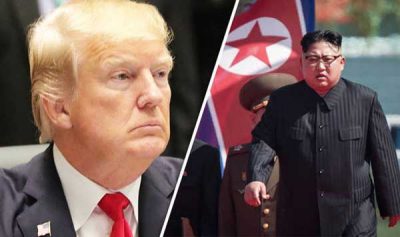
This text was envisaged for publication in E-Book format (pdf) in mid-December. In view of the evolving crisis on the Korean Peninsula and with a view to informing public opinion, Global Research has decided to release the preliminary draft version of Michel Chossudovsky’s essay entitled North Korea and the Dangers of Nuclear War: Towards the Implementation of a Peace Project.
A prior version of this essay was presented by Michel Chossudovsky in early November 2017 at the University of Quebec’s Observatoire de l’Asie de l’Est (OAE), Montreal.
This text forms the basis of Professor Chossudovsky’s presentation in Hamilton (December 18, 2017) and in Toronto (December 19). Michel Chossudovsky will be speaking in Winnipeg at UM and UW (Jan 15, 2018) and Vancouver Library (Jan 16 2018).
Copyright: Centre for Research on Globalization (CRG), Montreal, 2017. Cannot be published online or in print without the permission of Global Research
***
Take a stance against nuclear war.
Forward this document far and wide to friends and colleagues. The search engines are censoring independent analysis. The mainstream media is lying through omission.
Bear in mind that “MISTAKES” are often what determine the course of World History.
A Pre-emptive first strike US nuclear attack against North Korea could potentially precipitate a Third World War.
SAY NO TO NUCLEAR WAR. A PEACE PROCESS CAN BE NEGOTIATED.
HELP US Spread the word, forward this essay and consider making a donation to Global Research.
Our longer term objective is a World without War.
AND WE NEED THE SUPPORT OF OUR READERS
Michel Chossudovsky, November 30, 2017
***
Introduction: Dangerous Crossroads
Fire and Fury” was not invented by Donald Trump. It is a concept deeply embedded in US military doctrine. It has characterized US military interventions since the end of World War II.
What distinguishes Trump from his predecessors in the White House is his political narrative at the 2017 United Nations General Assembly.
We are nonetheless at a dangerous crossroads. Foreign policy miscalculation could lead to the unthinkable. We recall the circumstances of the Cuban Missile Crisis, fifty-five years ago in October 1962.
What distinguishes October 1962 to today’s realities is that the leaders on both sides, namely John F. Kennedy and Nikita S. Khrushchev were accutely aware of the dangers of nuclear annihilation.
In contrast, president Donald Trump is misinformed regarding the dangers of nuclear war, “We will have no choice but to totally destroy North Korea” accusing Kim Jong-un, of being a “rocket man” on “a suicide mission.”
On Sept. 3, North Korea conducted its sixth and largest nuclear test—a thermonuclear blast having a yield of 150 to 250 kilotons. In response, China and Russia voted for new sanctions at the UN Security Council. China’s central bank has also instructed other Chinese banks to stop providing financial services to North Korea. (ArmsControl.org, October 2017)
The History of “Fire and Fury”
President Harry Truman from the very outset of the Korean War (1950-53) was a firm advocate of “Fire and Fury” against the people of both North and South Korea. General Douglas MacArthur, who had actually carried out the atrocities directed against the Korean people appeared before the US Congress and:
“spoke of human suffering so horrifying that his parting glimpse of it caused him to vomit”.
“I have never seen such devastation,” the general told members of the Senate Armed Services and Foreign Relations committees. At that time, in May 1951, the Korean War was less than a year old. Casualties, he estimated, were already north of 1 million.
“I have seen, I guess, as much blood and disaster as any living man,” he added, “and it just curdled my stomach.” (quoted by the Washington Post, August 10, 2017)
Does the DPRK Constitute a Security Threat to the USA?
The American people should, in the words of Vietnam War Veteran Brian Willson “place themselves in the position of people living in targeted countries. That North Korea, a nation of 24 million people, i.e., one-twentieth the population of the U.S., many of them poor, a land slightly larger in area than the U.S. state of Pennsylvania, continues to be one of the most demonized nations and least understood, totally perplexes the Korean people.”
What most people in America do not know –and which is particularly relevant when assessing the alleged “threats” of the DPRK to World peace– is that North Korea lost thirty percent of its population as a result of US led bombings in the 1950s. US military sources confirm that 20 percent of North Korea’s population was killed off over a three period of intensive bombings:
“After destroying North Korea’s 78 cities and thousands of her villages, and killing countless numbers of her civilians, General Curtis LeMay remarked, “Over a period of three years or so we killed off – what – twenty percent of the population.”
It is now believed that the population north of the imposed 38th Parallel lost nearly a third its population of 8 – 9 million people during the 37-month long “hot” war, 1950 – 1953, perhaps an unprecedented percentage of mortality suffered by one nation due to the belligerance of another.” (quoted in Richard Rhodes, “The General and World War III,” The New Yorker, June 19, 1995, p. 53.)
Every single family in North Korea has lost a loved one in the course of the Korean War.
In comparison, during the Second World War the United Kingdom lost 0.94% of its population, France lost 1.35%, China lost 1.89% and the US lost 0.32%. During the Korean war, North Korea lost 30 % of its population.
These figures of civilian deaths in North Korea should also be compared to those compiled for Iraq by the Lancet Study (John Hopkins School of Public Health). The Lancet study estimated a total of 655,000 Iraqi civilian deaths, in the three years following the US led invasion (March 2003- June 2006).
The US never apologized for having killed 30 percent of North Korea’s population. Quite the opposite. The main thrust of US foreign policy has been to demonize the victims of US led wars.
There were no war reparations.
The issue of US crimes against the people of Korea was never addressed by the international community.
The atrocities of the Korean War set the stage for America’s war against the people of Vietnam.
For more than half a century, Washington has contributed to the political isolation and impoverishment of North Korea. Moreover, US sponsored sanctions on Pyongyang have contributed to destabilizing the country’s economy.
North Korea has been protrayed as part of an “axis of evil”. For what?
The unspoken victim of US military aggression, the DPRK is portrayed as a failed war-mongering “Rogue State”, a “State sponsor of terrorism” and a “threat to World peace”. These stylized accusations become part of a consensus, which we dare not question.
The Lie becomes the Truth. North Korea is heralded as a threat. America is not the aggressor but “the victim”.
Washington’s intent from the very outset was to destroy North Korea and demonize an entire nation. The US has also stood in the way of the reunification of North and South Korea.
People across America should put politics aside and relate to the suffering and hardships of the people of North Korea. War Veteran Brian Willson provides a moving assessment of the plight of the North Korean people:
“Everyone I talked with, dozens and dozens of folks, lost one if not many more family members during the war, especially from the continuous bombing, much of it incendiary and napalm, deliberately dropped on virtually every space in the country. “Every means of communication, every installation, factory, city, and village” was ordered bombed by General MacArthur in the fall of 1950. It never stopped until the day of the armistice on July 27, 1953. The pained memories of people are still obvious, and their anger at “America” is often expressed, though they were very welcoming and gracious to me. Ten million Korean families remain permanently separated from each other due to the military patrolled and fenced dividing line spanning 150 miles across the entire Peninsula.
Let us make it very clear here for western readers. North Korea was virtually totally destroyed during the “Korean War.” U.S. General Douglas MacArthur’s architect for the criminal air campaign was Strategic Air Command head General Curtis LeMay who had proudly conducted the earlier March 10 – August 15, 1945 continuous incendiary bombings of Japan that had destroyed 63 major cities and murdered a million citizens. (The deadly Atomic bombings actually killed far fewer people.).Eight years later, after destroying North Korea’s 78 cities and thousands of her villages, and killing countless numbers of her civilians, LeMay remarked, “Over a period of three years or so we killed off – what – twenty percent of the population.” It is now believed that the population north of the imposed 38th Parallel lost nearly a third its population of 8 – 9 million people during the 37-month long “hot” war, 1950 – 1953, perhaps an unprecedented percentage of mortality suffered by one nation due to the belligerance of another.
Virtually every person wanted to know what I thought of Bush’s recent accusation of North Korea as part of an “axis of evil.” I shared with them my own outrage and fears, and they seemed relieved to know that not all “Americans” are so cruel and bellicose. As with people in so many other nations with whom the U.S. has treated with hostility, they simply cannot understand why the U.S. is so obsessed with them.”(Brian Willson, Korea and the Axis of Evil, Global Research, October 12, 2006 emphasis added)
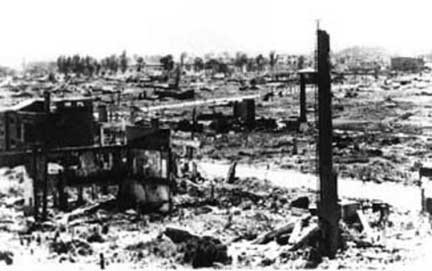
Pyongyang 1953
The Nature of US Atrocities against the People of Korea
The DPRK’s Foreign Minister’s Cable to the United Nations Security Council confirmed the nature of the atrocities committed by the US against the people of North Korea, acting under the banner of the United Nations:
See original below.
“ON JANUARY 3 AT 10:30 AM, AN ARMADE OF 82 FLYING FORTRESSES LOOSED THEIR DEATH-DEALING LOAD ON THE CITY OF PYONGYANG. …
HUNDREDS OF TONS OF BOMBS AND INCENDIARY COMPOUND WERE SIMULTANEOUSLY DROPPED THROUGHOUT THE CITY, CAUSING ANNIHILATING FIRES. IN ORDER TO PREVENT THE EXTINCTION OF THESE FIRES, THE TRANS-ATLANTIC BARBARIANS BOMBED THE CITY WITH DELAYED-ACTION HIGH-EXPLOSIVE BOMBS WHICH EXPLODED AT INTERVALS THROUGHOUT FOR A WHOLE DAY, MAKING IT IMPOSSIBLE FOR THE PEOPLE TO COME OUT ONTO THE STREETS. THE ENTIRE CITY HAS NOW BEEN BURNING, ENVELOPED IN FLAMES, FOR TWO DAYS. BY THE SECOND DAY 7,812 CIVILIANS’ HOUSES HAD BEEN BURNT DOWN. THE AMERICANS WERE WELL AWARE THAT THERE WERE NO MILITARY OBJECTIVES LEFT IN PYONGYANG. …
THE NUMBER OF INHABITANTS OF PYONGYANG KILLED BY BOMB SPLINTERS, BURNT ALIVE AND SUFFOCATED BY SMOKE IS INCALCULABLE, SINCE NO COMPUTATION IS POSSIBLE. SOME FIFTY THOUSAND INHABITANTS REMAIN IN THE CITY, WHICH BEFORE THE WAR HAD A POPULATION OF FIVE HUNDRED THOUSAND.”
It was all for a good cause: the fight against “evil communism”. The doctrine of fighting communism acted as a powerful ideological instrument during the Cold War era.
Our message to US military servicemen and women at all levels of the military hierarchy.
Reverse the course of History. Abandon the Battle Field, Refuse to Fight!
For complete text of the cable addressed to the UN Security Council click UN Repository
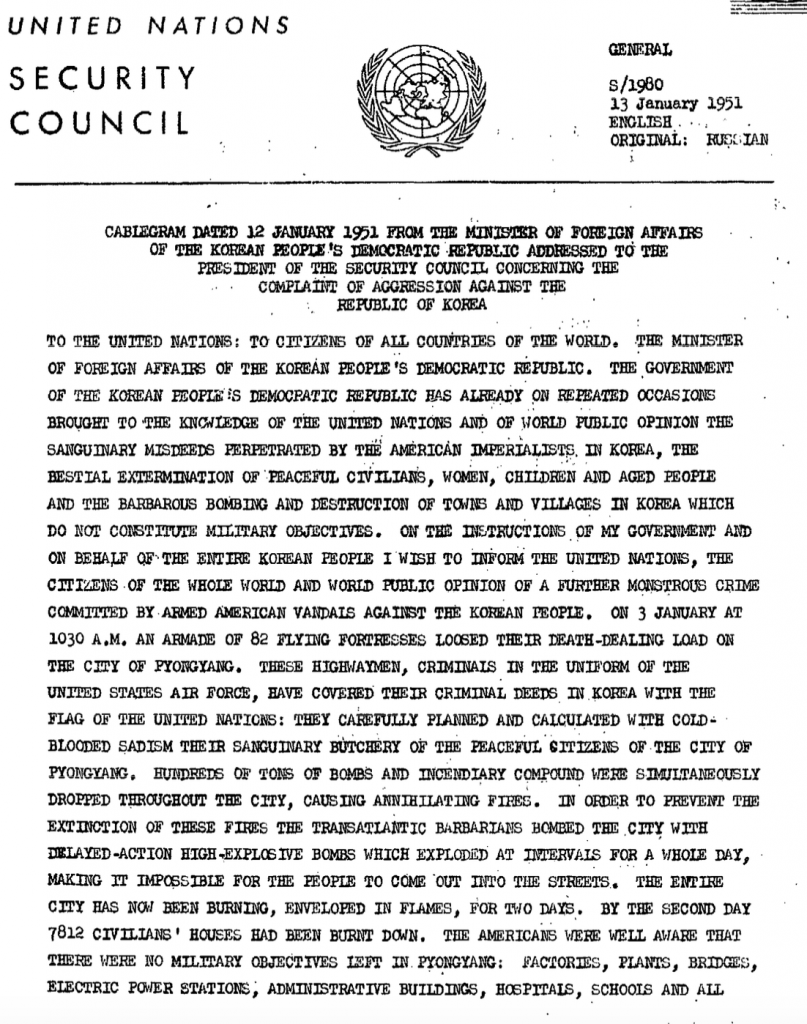
Video: Korean War: 600,000 Tons of American Bombs on the North. Every City was Destroyed
This episode details the UN bombing campaign over North Korea and the results for the people on the ground.
The majority of civilians killed in the Korean War were killed in North Korea by air attack. (This segment on the bombing of North Korea was censored from the US version of this documentary.).
Extensive war crimes committed by the United States.
Chapter I
Historical Context: Nuclear War, Who is the Aggressor?
Confirmed by US military documents, both the People’s Republic of China and the Democratic People’s Republic of Korea have been threatened with nuclear war for sixty-seven years.
In 1950, Chinese volunteer forces dispatched by the People’s Republic of China were firmly behind North Korea against US aggression.
China’s act of solidarity with The Democratic People’s Republic of Korea (DPRK) was carried out barely a few months after the founding of the PRC on October 1, 1949.
Truman had contemplated the use of nuclear weapons against both China and North Korea, specifically as a means to repeal the Chinese Volunteer People’s Army (VPA) which had been dispatched to fight alongside North Korean forces. [Chinese Volunteer People’s Army, 中國人民志願軍; Zhōngguó Rénmín Zhìyuàn Jūn].
It is important to stress that US military action directed against the DPRK was part of a broader Cold War military agenda against the PRC and the Soviet Union, the objective of which was ultimately to undermine and destroy socialism.
The Planning of Nuclear War against the Soviet Union
According to a secret document dated September 15, 1945, “the Pentagon had envisaged blowing up the Soviet Union with a coordinated nuclear attack directed against major urban areas.
All major cities of the Soviet Union were included in the list of 66 “strategic” targets. The tables below categorize each city in terms of area in square miles and the corresponding number of atomic bombs required to annihilate and kill the inhabitants of selected urban areas.
Six atomic bombs were to be used to destroy each of the larger cities including Moscow, Leningrad, Tashkent, Kiev, Kharkov, Odessa.
The Pentagon estimated that a total of 204 bombs would be required to “Wipe the Soviet Union off the Map”. The targets for a nuclear attack consisted of sixty-six major cities.
One single atomic bomb dropped on Hiroshima resulted in the immediate death of 100,000 people in the first seven seconds. Imagine what would have happened if 204 atomic bombs had been dropped on major cities of the Soviet Union as outlined in a secret U.S. plan formulated during the Second World War.
VIDEO: Wiping the Soviet Union Off the Map
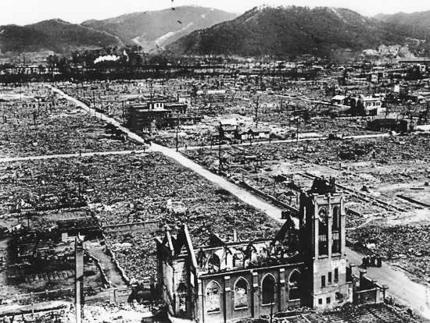
Hiroshima in the wake of the atomic bomb attack, 6 August 1945
The document outlining this diabolical military agenda had been released in September 1945, barely one month after the bombing of Hiroshima and Nagasaki (6 and 9 August, 1945) and two years before the onset of the Cold War (1947).
The secret plan dated September 15, 1945 (two weeks after the surrender of Japan on September 2, 1945 aboard the USS Missouri, see image below) , however, had been formulated at an earlier period, namely at the height of World War II, at a time when America and the Soviet Union were close allies.
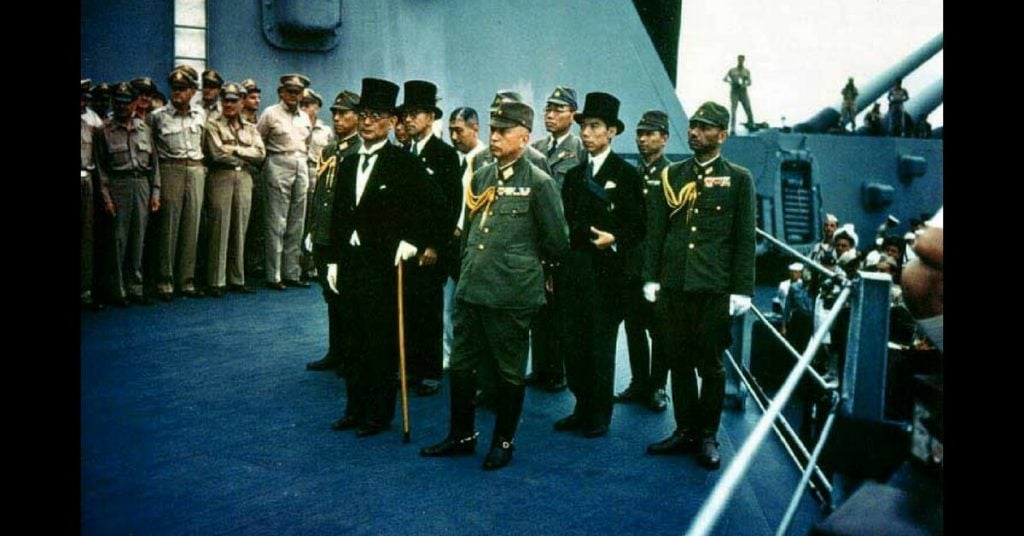
It is worth noting that Stalin was first informed through official channels by Harry Truman of the infamous Manhattan Project at the Potsdam Conference on July 24, 1945, barely two weeks before the attack on Hiroshima.
The Manhattan project was launched in 1939, two years prior to America’s entry into World War II in December 1941. The Kremlin was fully aware of the secret Manhattan project as early as 1942.
Were the August 1945 Hiroshima and Nagasaki attacks used by the Pentagon to evaluate the viability of a much larger attack on the Soviet Union consisting of more than 204 atomic bombs? The key documents to bomb 66 cities of the Soviet Union (15 September 1945) were finalized less than a month after the Hiroshima and Nagasaki bombings (6, 9 August 1945):
“On September 15, 1945 — just under two weeks after the formal surrender of Japan and the end of World War II — Norstad sent a copy of the estimate to General Leslie Groves, still the head of the Manhattan Project, and the guy who, for the short term anyway, would be in charge of producing whatever bombs the USAAF might want. As you might guess, the classification on this document was high: “TOP SECRET LIMITED,” which was about as high as it went during World War II. (Alex Wellerstein, The First Atomic Stockpile Requirements (September 1945)
The Kremlin was aware of the 1945 plan to bomb sixty-six Soviet cities.
The documents confirm that the US was involved in the “planning of genocide” against the Soviet Union.
Moreover, central to our understanding of the Cold War which started in 1947, Washington’s September 1945 plan to bomb 66 cities into smithereens played a key role in triggering the nuclear arms race.
The Soviet Union was threatened and developed its own atomic bomb in 1949. While the Kremlin knew about these plans to “Wipe out” the USSR, the broader public was not informed because the documents were of course classified.
Today, neither the 1945 plan to blow up the Soviet Union nor the underlying cause of the nuclear arms race are acknowledged. The Western media has largely focussed its attention on the Cold War US-USSR confrontation. The plan to annihilate the Soviet Union dating back to World War II and the infamous Manhattan project are not mentioned.
Washington’s Cold War nuclear plans are invariably presented in response to so-called Soviet threats, when in fact it was the U.S. September 1945 plan to wipe out the Soviet which motivated Moscow to develop its nuclear weapons capabilities.
Had the US decided not to develop nuclear weapons for use against the Soviet Union, the nuclear arms race would not have taken place. Neither The Soviet Union nor the People’s Republic of China would have developed nuclear capabilities as a means of “Deterrence”.
The Soviet Union lost 26 million people during World War II.
The USSR developed its own atomic bomb in 1949, in response to 1942 Soviet intelligence reports on the Manhattan Project.
Let’s cut to the chase. How many bombs did the USAAF request of the atomic general, when there were maybe one, maybe two bombs worth of fissile material on hand? At a minimum they wanted 123. Ideally, they’d like 466. This is just a little over a month after the bombings of Hiroshima and Nagasaki.
Of course, in true bureaucratic fashion, they provided a handy-dandy chart (Alex Wellerstein, op. cit)
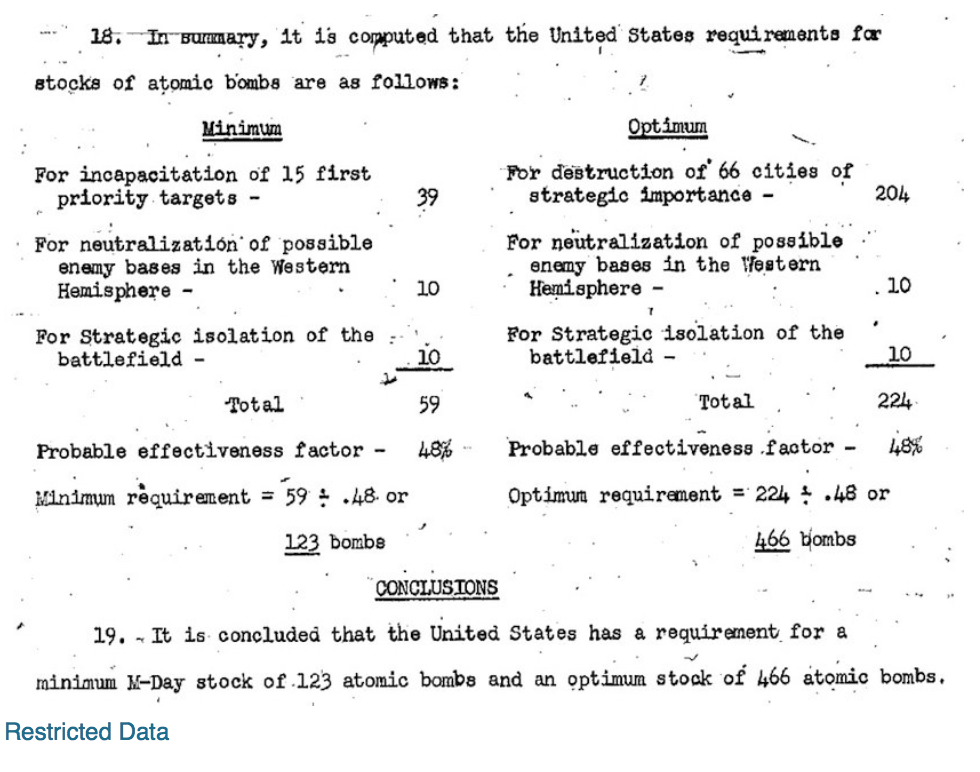
http://blog.nuclearsecrecy.com/wp-content/uploads/2012/05/1945-Atomic-Bomb-Production.pdf
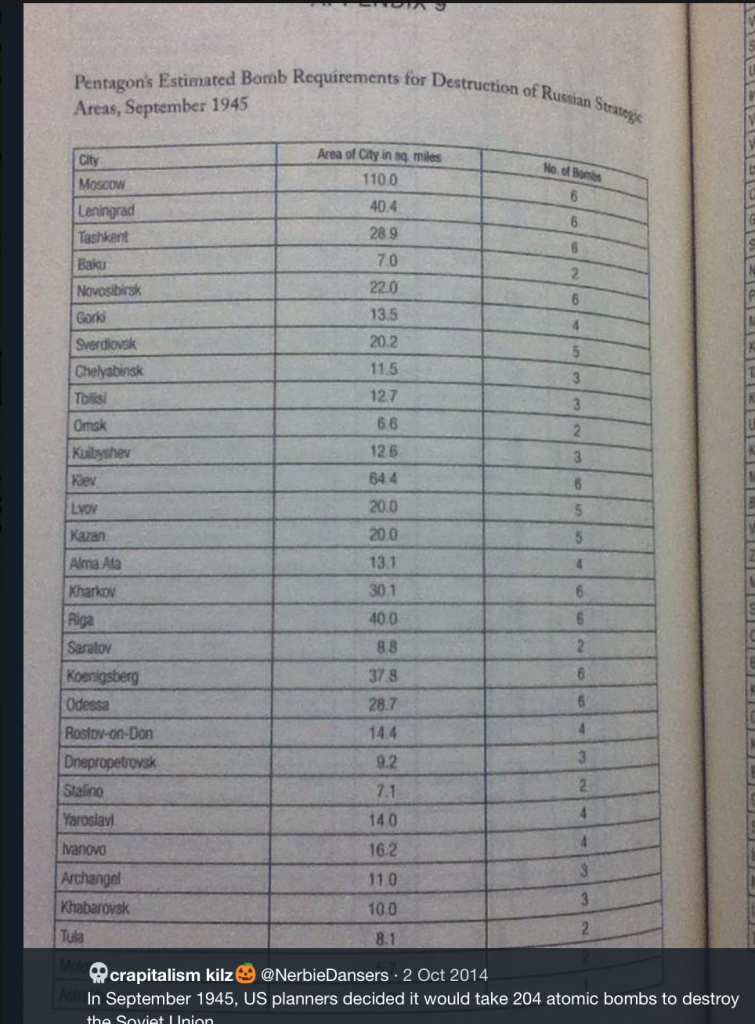
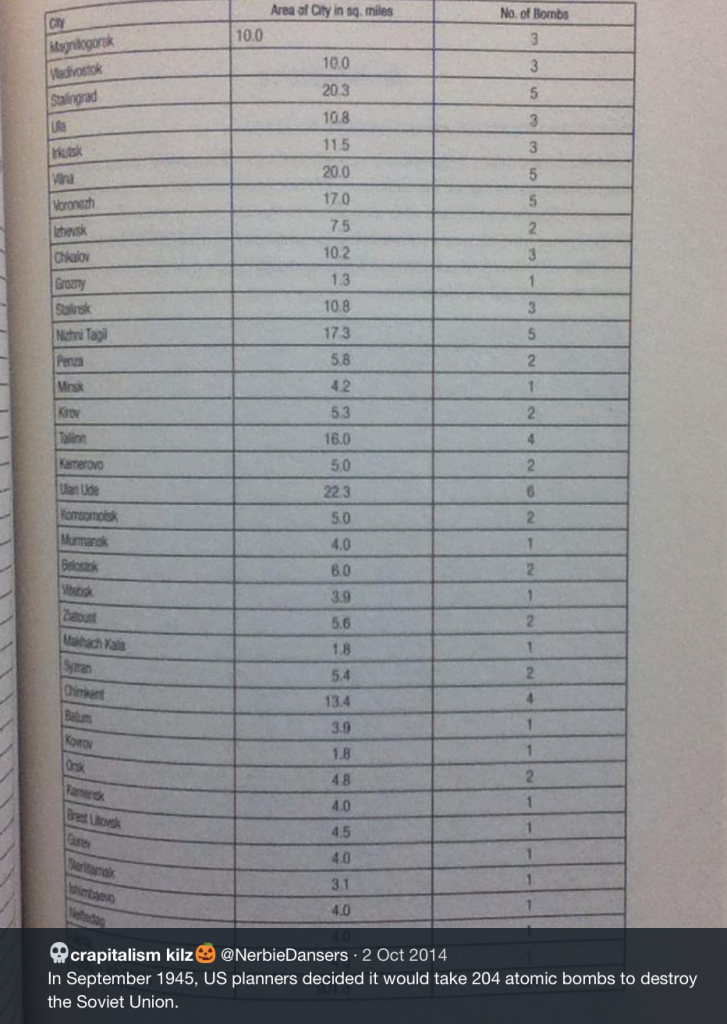
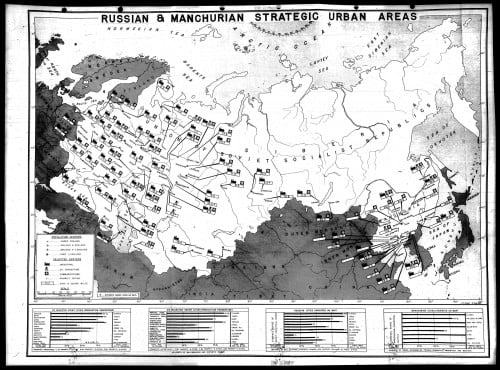
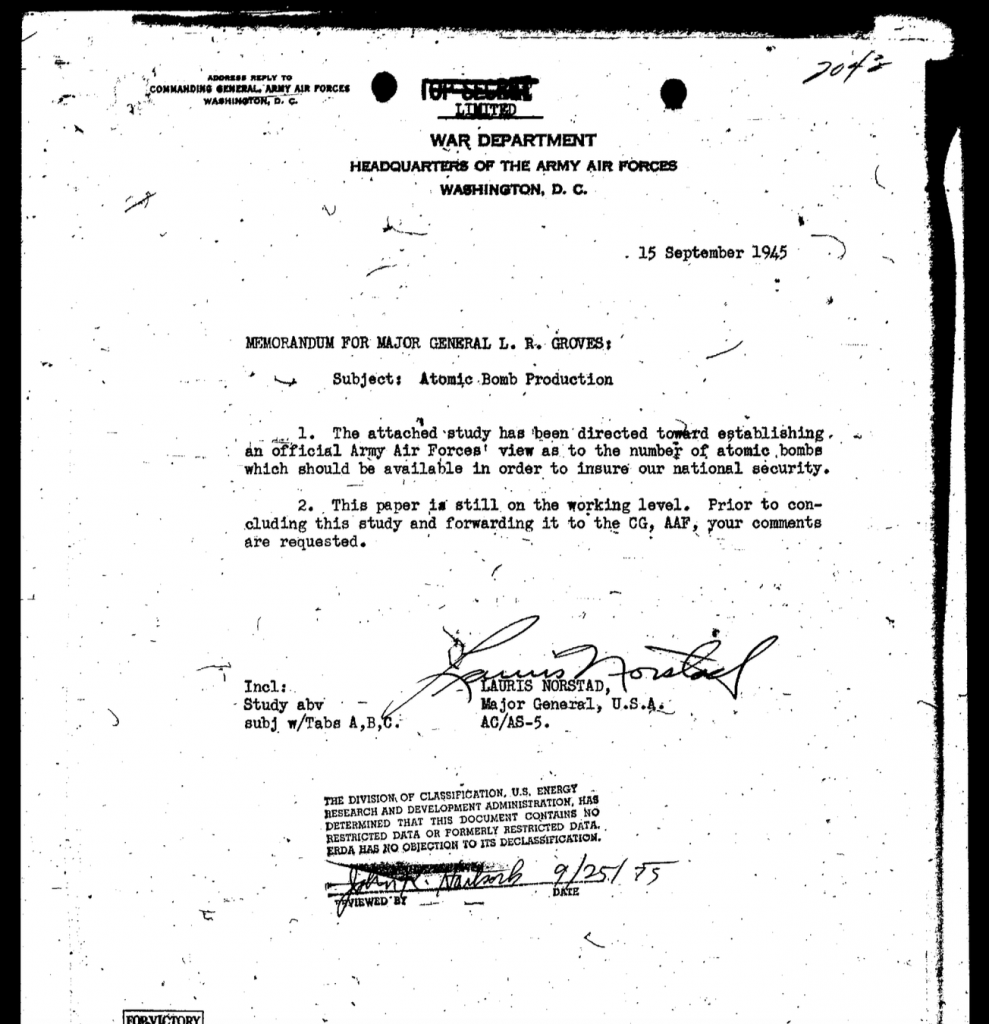
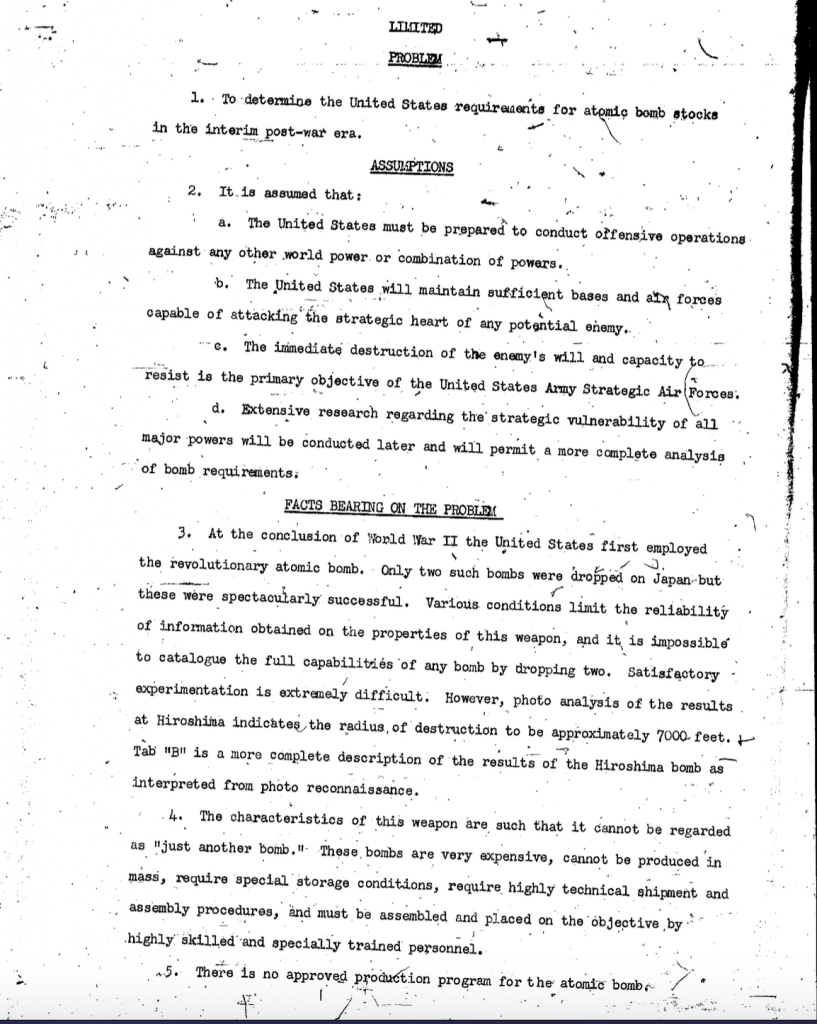
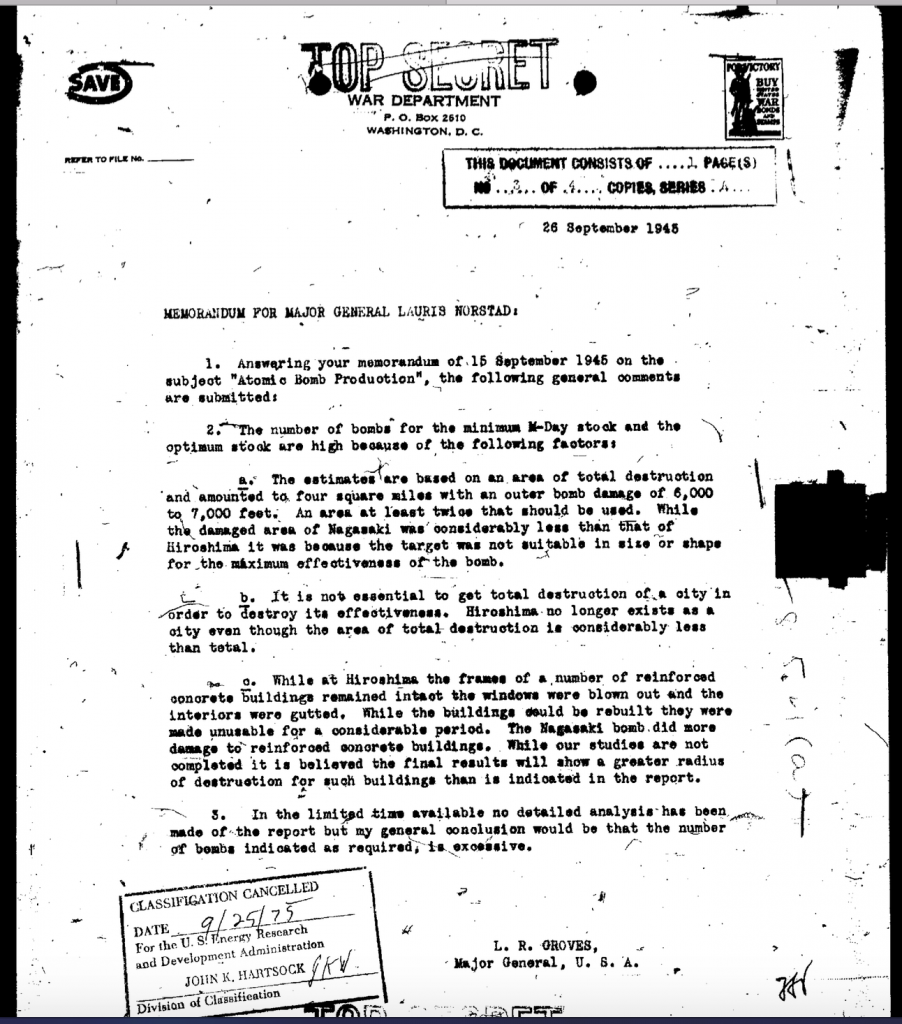
This initial 1945 list of sixty-six cities was updated in the course of the Cold War (1956) to include some 1200 cities in the USSR and the Soviet block countries of Eastern Europe (see declassified documents below).
Source: National Security Archive
“According to the 1956 Plan, H-Bombs were to be Used Against Priority “Air Power” Targets in the Soviet Union, China, and Eastern Europe. Major Cities in the Soviet Bloc, Including East Berlin, Were High Priorities in “Systematic Destruction” for Atomic Bombings. (William Burr, U.S. Cold War Nuclear Attack Target List of 1200 Soviet Bloc Cities “From East Germany to China”, National Security Archive Electronic Briefing Book No. 538, December 2015
Excerpt of list of 1200 cities targeted for nuclear attack in alphabetical order. National Security Archive
In the post Cold War era, under Donald Trump’s “Fire and Fury”, nuclear war directed against Russia, China, North Korea and Iran is “On the Table”.
What distinguishes the October 1962 Missile Crisis to Today’s Realities:
1. Today’s president Donald Trump does not have the foggiest idea as to the consequences of nuclear war.
2, Communication today between the White House and the Kremlin is at an all time low. In contrast, in October 1962, the leaders on both sides, namely John F. Kennedy and Nikita S. Khrushchev were accutely aware of the dangers of nuclear annihilation. They collaborated with a view to avoiding the unthinkable.
3. The nuclear doctrine was entirely different during the Cold War. Both Washington and Moscow understood the realities of mutually assured destruction. Today, tactical nuclear weapons with an explosive capacity (yield) of one third to six times a Hiroshima bomb are categorized by the Pentagon as “harmless to civilians because the explosion is underground”.
4. A one trillion ++ nuclear weapons program, first launched under Obama, is ongoing.
5. Today’s thermonuclear bombs are more than 100 times more powerful and destructive than a Hiroshima bomb. Both the US and Russia have several thousand nuclear weapons deployed.
Moreover, an all war against China is currently on the drawing board of the Pentagon as outlined by a RAND Corporation Report commissioned by the US Army
Washington is actively involved in creating divisions between China and its neighbours including the DPRK and the ROK.
The objective is to draw South East Asia and the Far East into a protracted military conflict by creating divisions between China and ASEAN countries, most of which are the victims of Western colonialism and US military aggression: Extensive crimes against humanity have been committed against Vietnam, Cambodia, Korea, the Philippines, Indonesia. In a bitter irony, these countries are now military allies of the United States.
Who is the Aggressor?
The Soviet Union had tested it’s first atomic bomb on August 29, 1949 in response to Washington’s design to wage nuclear war against the USSR, first formulated in September 1945.
According to analysts, the Soviet atomic bomb was instrumental in the Truman administration’s decision to eventually stall US nuclear war preparations against North Korea and China. The project was scrapped in June 1951.

In March 1949, President Truman approved National Security Council Memorandum 8/2, which identified the entire Korean peninsula “as an area where the principles of democracy were being matched against those of Communism.” (see P. K. Rose, Two Strategic Intelligence Mistakes in Korea, 1950, Perceptions and Reality, CIA Library, Apr 14, 2007.
The NSC Memorandum 8/2 paved the way for the June 1949 guerrilla attacks on the DPRK:
“Inquiry uncovers secret of series of attacks by South on North. South Korean troops attacked the North a year before the Korean war broke out, researchers have claimed in the latest disturbing revelation about the conflict which almost led to global war. More than 250 guerrillas from the South are said to have launched an attack on North Korean villages along the east coast in June 1949. The incident has been confirmed by a South Korean army official. (John Gittings, Martin Kettle, The Guardian, 17 January 2000)
Washington’s objective was to extend it’s geopolitical zone of influence over the entire Korean Nation, with a view to taking over all the Korean colonial territories which had been annexed to the Japanese Empire in 1910. The Korean war was also directed against the People’s Republic of China as confirmed by president Truman’s November 1950 statements (see transcript below), which intimated in no uncertain terms that the atomic bomb was intended to be used against the People’s Republic of China.
According to military analyst Carl A, Posey in Air and Space Magazine:
In late November [1950], communist China began to turn over its cards. It had already covertly sent troops into North Korea. …
With the Chinese intervention, the United States confronted a hard truth: Threatening a nuclear attack would not be enough to win the war. It was as if the Chinese hadn’t noticed—or, worse, weren’t impressed by—the atomic-capable B-29s waiting at Guam.
President Truman raised the ante. At a November press conference [1950], he told reporters he would take whatever steps were necessary to win in Korea, including the use of nuclear weapons. Those weapons, he added, would be controlled by military commanders in the field.
In April of the next year, Truman put the finishing touches on Korea’s nuclear war. He allowed nine nuclear bombs with fissile cores to be transferred into Air Force custody and transported to Okinawa. Truman also authorized another deployment of atomic-capable B-29s to Okinawa. Strategic Air Command set up a command-and-control team in Tokyo.
This spate of atomic diplomacy coincided with the end of the role played by Douglas MacArthur. … Truman replaced him with General Matthew Ridgway, who was given “qualified authority” to use the bombs if he felt he had to.
In October, there would be an epilogue of sorts to the Korean nuclear war. Operation Hudson Harbor would conduct several mock atomic bombing runs with dummy or conventional bombs across the war zone. Called “terrifying” by some historians, Hudson Harbor merely tested the complex nuclear-strike machinery, as the Strategic Air Command had been doing for years over American cities.
But the nuclear Korean war had already ended. In June 1951, the atomic-capable B-29s flew home, carrying their special weapons with them. (emphasis added)
Truman’s decision to contemplate the use of nuclear weapons is confirmed in Truman’s historic November 30, 1950 Press Conference
(Excerpts below, click to access complete transcript)

THE PRESIDENT. We will take whatever steps are necessary to meet the military situation, just as we always have.
[12.] Q. Will that include the atomic bomb ?
THE PRESIDENT, That includes every weapon that we have.
Q. Mr. President, you said “every weapon that we have.” Does that mean that there is active consideration of the use of the atomic bomb?
THE PRESIDENT. There has always been active consideration of its use. I don’t want to see it used. It is a terrible weapon, and it should not be used on innocent men, women, and children who have nothing whatever to do with this military aggression. That happens when it is used.3
3Later the same day the White House issued the following press release:
“The President wants to make it certain that there is no misinterpretation of his answers m questions at his press conference today about the use of the atom bomb. Naturally, there has been consideration of this subject since the outbreak of the hostilities in Korea, just as there is consideration of the use of all military weapons whenever our forces are in combat.
“Consideration of the use of any weapon is always implicit in the very possession of that weapon.
“However, it should be emphasized, that, by law, only the President can authorize the use of the atom bomb, and no such authorization has been given. If and when such authorization should be given, the military commander in the field would have charge of the tactical delivery of the weapon.
“In brief, the replies to the questions at today’s press conference do not represent any change in this situation.”
…
Q. Mr. President, I wonder if we could retrace that reference to the atom bomb? Did we understand you clearly that the use of the atomic bomb is under active consideration?
THE PRESIDENT. Always has been. It is one of our weapons.
Q. Does that mean, Mr. President, use against military objectives, or civilian–
THE PRESIDENT. It’s a matter that the military people will have to decide. I’m not a military authority that passes on those things. [refutes his earlier statement on not using it “against civilians”]
Q. Mr. President, perhaps it would be better if we are allowed to quote your remarks on that directly?
THE PRESIDENT. I don’t think–I don’t think that is necessary.
Q. Mr. President, you said this depends on United Nations action. Does that mean that we wouldn’t use the atomic bomb except on a United Nations authorization ?
THE PRESIDENT. No, it doesn’t mean that at all. The action against Communist China depends on the action of the United Nations. The military commander in the field will have charge of the use of the weapons, as he always has. [intimates that the use of atomic bomb is “against Communist China”]
[15.] Q. Mr. President, how dose are we to all-out mobilization.
THE PRESIDENT. Depends on how this matter we are faced with now works out.
[16.] Q. Mr. President, will the United Nations decide whether the Manchurian border is crossed, either with bombing planes or–
THE PRESIDENT. The resolution that is now pending before the United Nations will answer that question.
Q. Or with troops? … (emphasis added
In December 1949, a detailed top secret National Security Council (NSC) report was addressed to president Truman:

“Development of sufficient military power in selected non-Communist nations of Asia to maintain internal security and to prevent further encroachment by communism….
Gradual reduction and eventual elimination of the preponderant power and influence of the USSR in Asia
… The United States should continue to provide for the extension of political support and economic, technical, military and other assistance to the democratically-elected Government of the Republic of Korea.
(NSC top secret report, December 1949)
Beneath the facade of spreading democracy, Washington’s ultimate objective was to establish a proxy State in South Korea.
America’s appointee Sygman Rhee was flown into Seoul in October 1945, in General Douglas MacArthur’s personal airplane, Rhee became president in 1948, with a mandate to curb political dissent including the arrest, torture and assassination of thousands of alleged Communist opponents.
Mutually Assured Destruction (MAD)
The doctrine of mutually assured destruction (MAD) evolved in the wake of the launching of the Soviet atom bomb in August 1949. Prior to that, the US resolve was to use nukes on a first strike basis against the Soviet Union, the People’s Republic of China and the Democratic People’s Republic of Korea (DPRK).
However, at the outset of the Korean war in 1950, confirmed by Truman’s statements, no clearcut distinction was made between a nuclear weapon and a conventional weapon. The Truman administration’s nuclear doctrine consisted in using nuclear weapons within the framework of a conventional war theater.
The concept of Mutually Assured Destruction (MAD) which characterized the Cold War was based on the recognition that the use of nuclear weapons “by two or more opposing sides would cause the complete annihilation of both the attacker and the defender”.
China was first threatened by the US with nuclear war in 1950, a year after the inauguration of the People’s Republic of China. Some 14 years later in October 1964, China tested its first 16-ton nuclear bomb.
Chapter II
The Threat of Nuclear War.
North Korea vs. the United States
While the Western media portrays North Korea’s nuclear weapons program as a threat to Global Security, it fails to acknowledge that the US has being threatening North Korea with a nuclear attack for more than half a century“
The Hiroshima Doctrine” applied to North Korea
The strategic objective of a nuclear attack under the “Hiroshima doctrine” was to trigger a “massive casualty producing event”resulting in tens of thousands of deaths. The objective was to terrorize an entire nation, as a means of military conquest. Military targets were not the main objective: the notion of “collateral damage” was used as a justification for the mass killing of civilians, under the official pretence that Hiroshima was “a military base” and that civilians were not the target.
In the words of President Harry Truman:
“We have discovered the most terrible bomb in the history of the world. … This weapon is to be used against Japan … [We] will use it so that military objectives and soldiers and sailors are the target and not women and children. Even if the Japs are savages, ruthless, merciless and fanatic, we as the leader of the world for the common welfare cannot drop that terrible bomb on the old capital or the new. … The target will be a purely military one… It seems to be the most terrible thing ever discovered, but it can be made the most useful.” (President Harry S. Truman, Diary, July 25, 1945)
“The World will note that the first atomic bomb was dropped on Hiroshima a military base. That was because we wished in this first attack to avoid, insofar as possible, the killing of civilians..”(President Harry S. Truman in a radio speech to the Nation, August 9, 1945).
[Note: the first atomic bomb was dropped on Hiroshima on August 6, 1945; the Second on Nagasaki, on August 9, on the same day as Truman’s radio speech to the Nation]
Nobody within the upper echelons of the US government and military believed that Hiroshima was a military base, Truman was lying to himself and to the American public. To this day the use of nuclear weapons against Japan is justified as a necessary cost for bringing the war to an end and ultimately “saving lives”.
US Nuclear Weapons Stockpiled and Deployed in South Korea
Barely a few years after the end of the Korean War, the US initiated its deployment of nuclear warheads in South Korea. This deployment in Uijongbu and Anyang-Ni had been envisaged as early as 1956.
It is worth noting that the US decision to bring nuclear warheads to South Korea was in blatant violation of Paragraph 13(d) of the Armistice Agreement which prohibited the warring factions from introducing new weapons into Korea.
The actual deployment of nuclear warheads started in January 1958, four and a half years after the end of the Korean War, “with the introduction of five nuclear weapon systems: the Honest John surface-to-surface missile, the Matador cruise missile, the Atomic-Demolition Munition (ADM) nuclear landmine, and the 280-mm gun and 8-inch (203mm) howitzer.” (See The nuclear information project: US Nuclear Weapons in Korea)
The Davy Crockett projectile was deployed in South Korea between July 1962 and June 1968. The warhead had selective yields up to 0.25 kilotons. The projectile weighed only 34.5 kg (76 lbs). Nuclear bombs for fighter bombers arrived in March 1958, followed by three surface-to-surface missile systems (Lacrosse, Davy Crockett, and Sergeant) between July 1960 and September 1963. The dual-mission Nike Hercules anti-air and surface-to-surface missile arrived in January 1961, and finally the 155-mm Howitzer arrived in October 1964. At the peak of this build-up, nearly 950 warheads were deployed in South Korea.
Four of the weapon types only remained deployed for a few years, while the others stayed for decades. The 8-inch Howitzer stayed until late 1991, the only weapon to be deployed throughout the entire 33-year period of U.S. nuclear weapons deployment to South Korea. The other weapons that stayed till the end were the air delivered bombs (several different bomb types were deployed over the years, ending with the B61) and the 155-mm Howitzer nuclear artillery. (Nuclear Information Project, op. cit)
Officially the US deployment of nuclear weapons in South Korea lasted for 33 years. The deployment was targeted against North Korea as well as China and the Soviet Union.
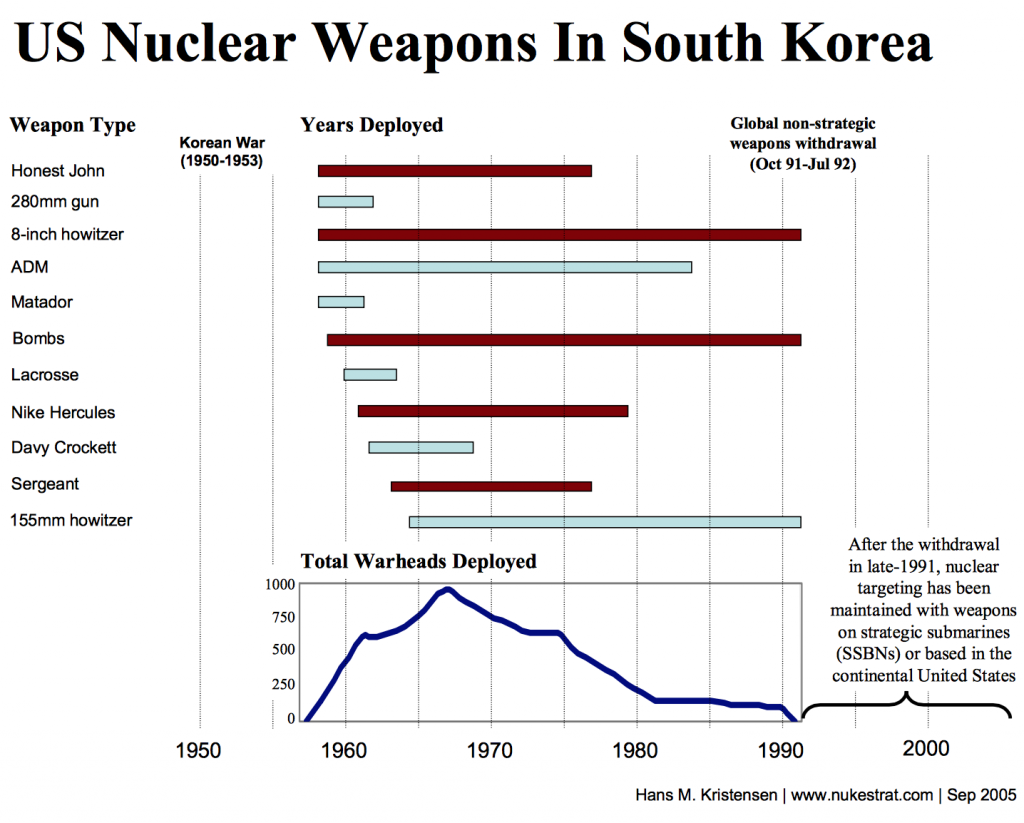
South Korea’s Nuclear Weapons Program
Concurrent and in coordination with the US deployment of nuclear warheads in South Korea, the ROK had initiated its own nuclear weapons program in the early 1970s.
The official story is that the US exerted pressure on Seoul to abandon their nuclear weapons program and “sign the Treaty on the Non-Proliferation of Nuclear Weapons (NPT) in April 1975 before it had produced any fissile material.” (Daniel A. Pinkston, “South Korea’s Nuclear Experiments,” CNS Research Story, 9 November 2004, http://cns.miis.edu.]
The ROK’s nuclear initiative was from the outset in the early 1970s under the supervision of the US and was developed as a component part of the US deployment of nuclear weapons, with a view to threatening North Korea.
Double Standards: While the West in chorus accuses the DPRK of developing nuclear capabilities, the development of a nuclear weapons program in South Korea was never an issue. Neither was the ROK designated as an undeclared nuclear weapons state.
Moreover, while this program was officially ended in 1978, the US promoted scientific expertise as well as training of the ROK military in the use of nuclear weapons. And bear in mind: under the ROK-US CFC agreement, all operational units of the ROK are under joint command headed by a US General. This means that all the military facilities and bases established by the Korean military are de facto joint facilities. There are a total of 27 US military facilities in the ROK (See List of United States Army installations in South Korea – Wikipedia)
The Planning of Nuclear Attacks against North Korea from the Continental US and from Strategic US Submarines
According to military sources, the removal of US nuclear weapons from South Korea was initiated in the mid 1970s. It was completed in 1991:
The nuclear weapons storage site at Osan Air base was deactivated in late 1977. This reduction continued over the following years and resulted in the number of nuclear weapons in South Korea dropping from some 540 in 1976 to approximately 150 artillery shells and bombs in 1985. By the time of the Presidential Nuclear Initiative in 1991, roughly 100 warheads remained, all of which had been withdrawn by December 1991. (The nuclear information project: withdrawal of US nuclear weapons from South Korea)
According to official statements, the US withdrew its nuclear weapons from South Korea in December 1991.
This withdrawal from Korea did not in any way modify the US threat of nuclear war directed against the DPRK. On the contrary: it was tied to changes in US military strategy with regard to the deployment of nuclear warheads. Major North Korean cities were to be targeted with nuclear warheads from US continental locations and from US strategic submarines (SSBN) rather than military facilities in South Korea:
After the withdrawal of [US] nuclear weapons from South Korea in December 1991, the 4th Fighter Wing at Seymour Johnson Air Force Base has been tasked with nuclear strike planning against North Korea. Since then, strike planning against North Korea with non-strategic nuclear weapons has been the responsibility of fighter wings based in the continental United States. One of these is the 4th Fighter Wing at Seymour Johnson Air Force Base in North Carolina. …
“We simulated fighting a war in Korea, using a Korean scenario. … The scenario…simulated a decision by the National Command Authority about considering using nuclear weapons….We identified aircraft, crews, and [weapon] loaders to load up tactical nuclear weapons onto our aircraft….
With a capability to strike targets in less than 15 minutes, the Trident D5 sea-launched ballistic missile is a “mission critical system” for U.S. Forces Korea. Ballistic Missile Submarines and Long-Range Bombers
In addition to non-strategic air delivered bombs, sea-launched ballistic missiles onboard strategic Ohio-class submarines (SSBNs) patrolling in the Pacific appear also to have a mission against North Korea. A DOD General Inspector report from 1998 listed the Trident system as a “mission critical system” identified by U.S. Pacific Command and U.S. Forces Korea as “being of particular importance to them.”
Although the primary mission of the Trident system is directed against targets in Russia and China, a D5 missile launched in a low-trajectory flight provides a unique very short notice (12-13 minutes) strike capability against time-critical targets in North Korea. No other U.S. nuclear weapon system can get a warhead on target that fast. Two-three SSBNs are on “hard alert” in the Pacific at any given time, holding Russian, Chinese and North Korean targets at risk from designated patrol areas.
Long-range strategic bombers may also be assigned a nuclear strike role against North Korea although little specific is known. An Air Force map suggests a B-2 strike role against North Korea. As the designated carrier of the B61-11 earth penetrating nuclear bomb, the B-2 is a strong candidate for potential nuclear strike missions against North Korean deeply buried underground facilities.
As the designated carrier of the B61-11 earth penetrating nuclear bomb [with an explosive capacity between one third and six times a Hiroshima bomb] and a possible future Robust Nuclear Earth Penetrator, the B-2 stealth bomber could have an important role against targets in North Korea. Recent upgrades enable planning of a new B-2 nuclear strike mission in less than 8 hours. (The nuclear information project: withdrawal of US nuclear weapons from South Korea, emphasis added))
The Bush Administration’s 2001 Nuclear Posture Review: Pre-emptive Nuclear War
The Bush administration in its 2001 Nuclear Posture Review established the contours of a new post 9/11 “pre-emptive” nuclear war doctrine, namely that nuclear weapons could be used as an instrument of “self-defense” against non-nuclear states
“Requirements for U.S. nuclear strike capabilities” directed against North Korea were established as part of a Global Strike mission under the helm of US Strategic Command Headquarters in Omaha Nebraska, the so-called CONPLAN 8022, which was directed against a number of “rogue states”including North Korea as well as China and Russia.
On November 18, 2005, the new Space and Global Strike command became operational at STRATCOM after passing testing in a nuclear war exercise involving North Korea.
Current U.S. Nuclear strike planning against North Korea appears to serve three roles: The first is a vaguely defined traditional deterrence role intended to influence North Korean behavior prior to hostilities.
This role was broadened somewhat by the 2001 Nuclear Posture Review to not only deter but also dissuade North Korea from pursuing weapons of mass destruction.
Why, after five decades of confronting North Korea with nuclear weapons, the Bush administration believes that additional nuclear capabilities will somehow dissuade North Korea from pursuing weapons of mass destruction [nuclear weapons program] is a mystery. (Ibid, emphasis added)
Asymmetry of Nuclear Capabilities?
The asymmetry of nuclear weapons capabilities between the US and the DPRK must be emphasised. According to ArmsControl.org (April 2013) the United States:
“possesses 5,113 nuclear warheads, including tactical, strategic, and non-deployed weapons.”
According to the latest official New START declaration, out of more than 5113 nuclear weapons,
“the US deploys 1,654 strategic nuclear warheads on 792 deployed ICBMs, SLBMs, and strategic bombers…”ArmsControl.org (April 2013).
The latest estimates place the DPRK’s nuclear capabilities at 1o nuclear warheads.
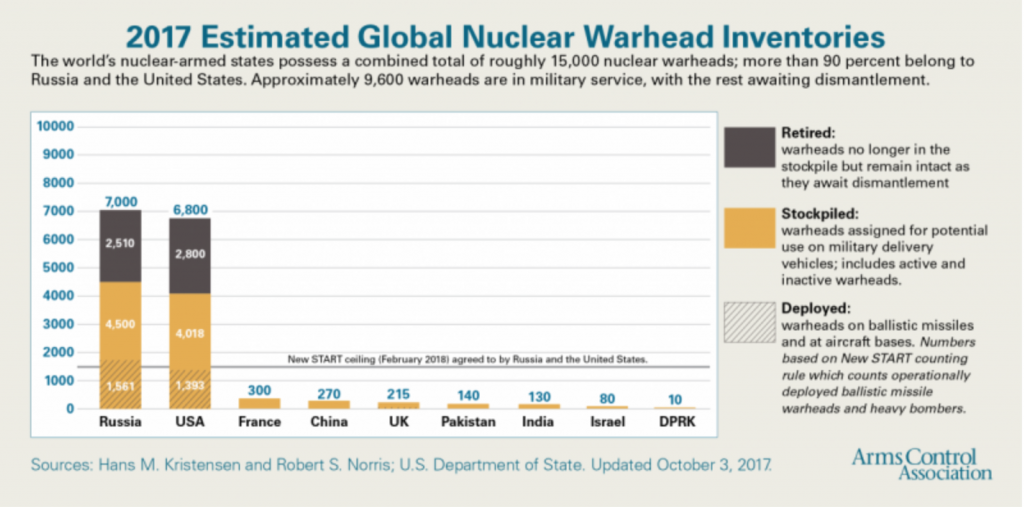
Source: www.Sipri.org
Moreover, according to The Federation of American Scientists the U.S. possesses 500 tactical nuclear warheads. (ArmsControl.org April 2013).
The tables above do not include the nuclear capabilities of Five Undeclared Nuclear Weapons States, Belgium, Netherlands, Germany, Italy, Turkey, which possess and deploy 150 B61 tactical nuclear weapons, weapons are directed against Russia, Iran and countries in the Middle East.
While the nuclear warheads are made in America, they are entirely under national command.
Nobody seems to be concerned and the issue is not an object of media coverage. Belgium is reported to have 20 B61 nuclear weapons under national command, Turkey has 50.
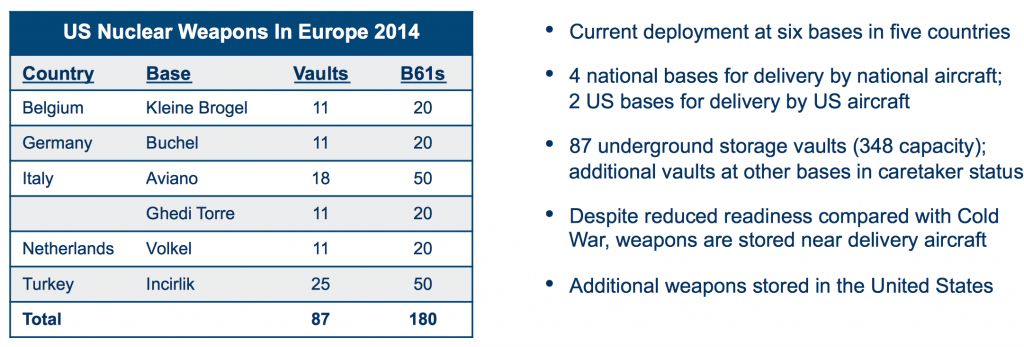
Source: Hans M. Kristensen, Federation of American Scientists,
presentation to Dutch and Belgian parliamentary committees , 2014
Double standards. No Trump “Fire and Fury” directed against Holland or Belgium, which possess 40 nuclear weapons under national command. Compare that to the DPRK’s 10 nuclear weapons,heralded as a “threat” to the security of the Western World.
The Democratic People’s Republic of Korea, the unspoken victim of US military aggression, has been incessantly portrayed as a war mongering nation, a menace to the American Homeland and a “threat to World peace”. These stylized accusations have become part of a media consensus.
The threat of nuclear war does not emanate from the DPRK but from the US and its allies.Meanwhile, Washington is now implementing a $32 billion refurbishing of strategic nuclear weapons as well as a revamping of its tactical nuclear weapons, which according to a 2002 Senate decision “are harmless to the surrounding civilian population.”
These continuous threats and actions of latent aggression directed against the DPRK should also be understood as part of the broader US military agenda in East Asia, directed against China and Russia.
It is important that people across the land, in the US, Western countries, come to realize that the United States rather than North Korea or Iran is a threat to global security.
Political Insanity and Nuclear War
Insanity in US foreign policy, not to mention the fiction that nuclear weapons are an “instrument of peace” could lead to the unthinkable.
A One Trillion dollar nuclear weapons program was launched under the Obama administration.
Trump wisely pushed it to $1.2 Trillion:
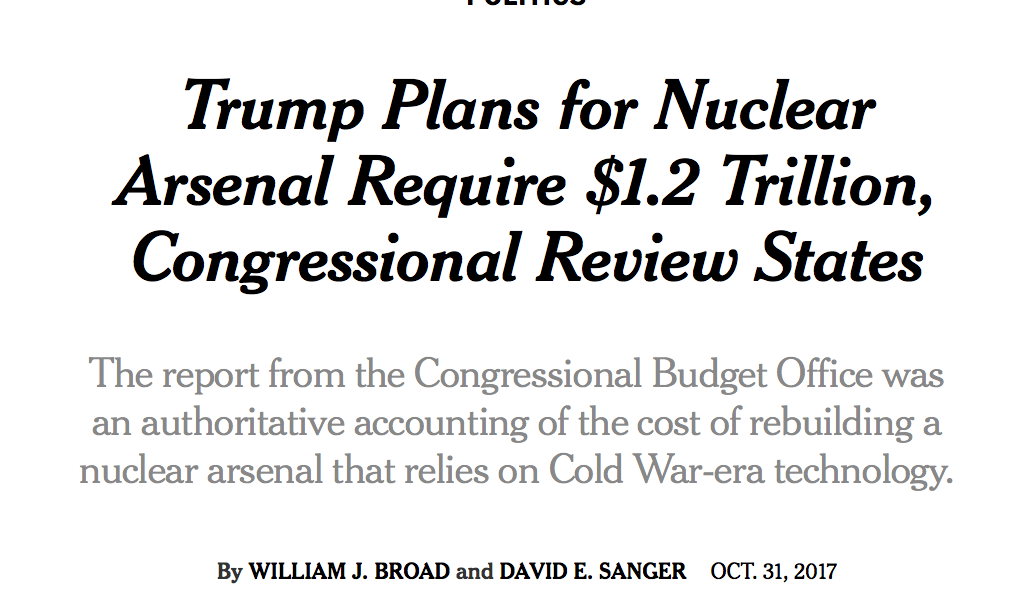
Screenshot of New York Times
There is a long history of US political insanity geared towards providing a human face to U.S. crimes against humanity.
On August 9, 1945 on the day the second atomic bomb was dropped on Nagasaki, president Truman (image right), in a radio address to the American people, concluded that God is on the side
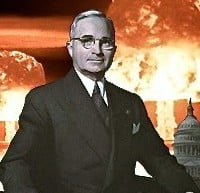 of America with regards to the use of nuclear weapons and that
of America with regards to the use of nuclear weapons and that“He May guide us to use it [nuclear weapons] in His ways and His purposes”.
According to Truman: God is with us, he will decide if and when to use the bomb:
[We must] prepare plans for the future control of this bomb. I shall ask the Congress to cooperate to the end that its production and use be controlled, and that its power be made an overwhelming influence towards world peace.
We must constitute ourselves trustees of this new force–to prevent its misuse, and to turn it into the channels of service to mankind.
It is an awful responsibility which has come to us.
We thank God that it [nuclear weapons] has come to us, instead of to our enemies; and we pray that He may guide us to use it [nuclear weapons] in His ways and for His purposes” (emphasis added)
Speaking at the Foreign Correspondents’ Club of Japan Professor Michel Chossudovsky of the Centre for Research on Globalization describes how the United States presents the real threat of nuclear war on the Korean Peninsula.
This GRTV video was first published in 2013 in the context of the 60th commemoration of the 1953 Armistice Agreement.
Chapter III
On the Pentagon’s Hit List
A War on North Korea
Would Engulf the Entire Northeast Asian Region
Geography 101: “Get Trump an Atlas”. Trump Wants to Bomb North Korea With Nuclear Weapons. Where is the Target Country?
George W, Bush was known for his total ignorance of geography. “Dubya the Geographer: Someone Buy This Man an Atlas” appears in dubyaspeak.com, Dubya Speaks, We Record the Damage.
Fast forward to 2017: What about Donald Trump who has his thumb on the nuclear button. What is his knowledge of geography.
“If you’re sweating the possibility of a Donald Trump presidency, take this to heart — at least he’s not running to be anyone’s eighth grade geography teacher.” Jeva Lange quoted in This Week, June 15, 2016)
“Nothing in all the world is more dangerous than sincere ignorance and conscientious stupidity”.Martin Luther King Jr.
While many Americans may be ignorant regarding the World’s geography, they nonetheless expect that their elected president as well as his foreign policy advisers know “where the countries are”, particularly those countries which are on the Pentagon’s hit list.
What is the “damage” of ignorance among Trump’s foreign policy makers? In the words of Donald Trump:
“best not make any more threats to the United States. … [Kim Jong-un] has been very threatening – beyond a normal statement – and as I said, they will be met with fire, fury and, frankly, power the likes of which the world has never seen before.” (emphasis added)
“Trump Speaks, We Record the Damage.” What is the “Damage” underlying Trump’s “fire, fury and power …” threats implying the preemptive use of nuclear weapons against North Korea?
And who will be around to “Record the Damage” in the wake of a world war?
Ask Trump, Where is North Korea?
Where is the target country?
A preventive first strike nuclear attack is now being contemplated against North Korea. And this is where Geography 101 comes in.
The distance between the centre of South Korea’s capital Seoul and the Demilitarized Zone (DMZ) marking the border with North Korea is 57 km or 35 miles, half the distance between Manhattan and New Jersey (71 miles via Interstate Highway 95S).
The distance between Seoul and Pyongyang is about 121 miles, less than the distance between the Trump Tower in Manhattan and The Trump Taj Mahal Casino in Atlantic City (131 miles)
Trump World Tower Manhattan
Pyongyang; Compare the towers: Pyongyang vs. NYC
South Korea’s Gimpo international airport is barely 2 miles from the border with North Korea.
The distance between Seoul and the historical city of Kaesong in North Korea is 40 miles.
A nuclear attack against the DPRK would inevitably engulf both North and South Korea, ie. the entire Korean peninsula, depending on the size and explosive yield of the nuclear bombs.
The Geopolitical Context: China, Russia, North Korea, South Korea, Japan
Pyongyang is close to the Chinese border. The DPRK has a border with the Russian Federation. The City of Vladivostok is approximately 60 miles from the DPRK border.
The entire Northeast Asian region –which largely consists of five countries– would also be affected by the nuclear blast. In a bitter irony, two of these countries, namely Japan and South Korea are staunch allies and military partners of the US.
Source: screenshot of Google maps
What would be the nature of the unspoken “damage” resulting from a US led nuclear attack against the DPRK?
According to “scientific opinion” on contract to the Pentagon, the mini-nukes (tactical nuclear weapons) (e.g. B61-11) with an explosive yield of up to 6 times a Hiroshima bomb are, “harmless to the surrounding civilian population because the explosion is underground”.
It’s a big lie which is now embedded in the military manuals. And those lies are part of the daily intelligence briefings which are fed to president Donald Trump who as Commander in Chief has the real powers of unleashing a nuclear war.
The Hiroshima bomb on August 6, 1945 was conducive to 100,000 killed or doomed in 9 seconds. Todays bombs (including the mini-nukes) are much more powerful.
Trump’s war against the DPRK is not only a war against the entire Korean nation.
The decision to use nuclear weapons against the DPRK could be a prelude to World War III.
Chapter IV
Propaganda: Falsifying Social Realities in North Korea
The North Korean government, according to the Western media is said to be oppressing and impoverishing its population.
According to US News and World Report,
“North Korea is one of the most miserable places on earth. The standard of living has deteriorated to extreme levels of deprivation in which the right to food security, health and other minimum needs for human survival are denied,”
Here in the USA we have medicare, all our kids are educated, we are all literate, and “we want to live in America”.
And in the DPRK, the health system sucks, they don’t have schools and hospital beds, they are all a bunch of illiterates,
You would not want to live there! (author’s paraphrase)
Beneath the mountain of media disinformation, there is more than meets the eye. Despite economic sanctions and military threats, not to mention the failed intent of “respectable” human rights organizations (including Amnesty International) to distort the facts, North Korea’s “health system is the envy of the developing world”
according to the Director General of the World Health Organization:
“WHO director-general Margaret Chan said the country had “no lack of doctors and nurses””.
Screen shot of April 2010 BBC report
Health. DPRK vs. USA
While praising North Korea, the WHO admonishes the USA for “not having a universal health coverage”:
Screenshot CNBC Report, February 2017 quoting a study by the WHO and Imperial College London
Lets look at the figures. The Library of Congress Federal Research Division quoting official sources concurs:
North Korea has a national medical service and health insurance system. As of 2000, some 99 percent of the population had access to sanitation, and 100 percent had access to water, but water was not always potable. Medical treatment is free. In the past, there reportedly has been one doctor for every 700 inhabitants and one hospital bed for every 350 inhabitants
“In 2006 life expectancy was estimated at 74.5 years for women and 68.9 for men, or nearly 71.6 years total.”
Higher than in most developing countries. Lower than in the United States.
Can we trust official US-UN sources?
In America we have medicare.
Education: DPRK vs. USA
What about their run down schools, serving an illiterate North Korean population?
According to UNESCO, Public Education in the Democratic People’s Republic of Korea (DPRK) is universal and fully funded by the State. According to US official government sources (Library of Congress Federal Research Division):
“Education in North Korea is free, compulsory, and universal for 11 years, from ages four to 15, in state-run schools. The national literacy rate for citizens 15 years of age and older is 99 percent. (Library of Congress, Federal Research Division, p. 7)
In contrast in the USA, according to the US Department of Education Surveys, the Adult Illiteracy rate (16 and older) is of the order of 13.6% and 14.5% depending on the criterion (2003 data).
There is a 99% percent adult literacy rate in North Korea compared to about 86% in the USA.
That sounds crazy! Who is fiddling with the data? These are all official UN-US statistics.
“The national direct estimates of the percentages of adults lacking BPLS (Basic Prose Literacy Skills) are 14.5 percent for the 2003 NAAL and 14.7 percent for the 1992 NALS. In comparison, the national direct estimates of the percentages Below Basic in prose literacy are 13.6 percent for the NAAL and 13.8 percent for the NALS. (National Center for Education Statistics)
Educational achievement measured in terms of adult literacy in the DPRK is higher than in the United States of America?
And how did they reach this performance with a US sponsored economic sanctions regime extending over a period of more than 20 years?
Pyongyang capital of North Korea, in 1953, almost entirely destroyed by U.S. bombing during the Korean War.
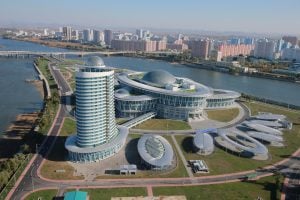
Pyongyang today, rebuilt. Science Complex: Photo Andrew Korybko
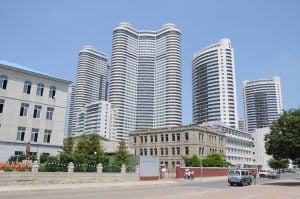
Pyongyang; public housing. Photo Andrew Korybko
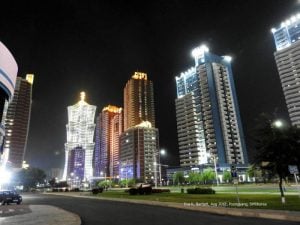
Photo: Eva Bartlett
Pyongyang today rebuilt: Dispels the myth of a backward urban society. Trump wants to reduce Pyongyang to rubble.
Do the Pyongyang towers (see image above) compete with Manhattan’s Trump Tower? Ask Donald Trump.
Chapter V
The Candlelight Movement, The Demilitarization of the Korean Peninsula
The 1987 June Democratic Uprising was a nationwide grassroots movement in the Republic of Korea (ROK) directed against the military regime of president Chun Doo-hwan, a ROK army general who came to power in 1979 following a military coup and the assassination of President General Park Chung-hee.
Chun Doo-hwan (1979-1987) had announced the appointment of a new military dictator: Army GeneralRoh Tae-woo as the next unelected president of the ROK.
This self-proclaimed decision in defiance of public sentiment was conducive to the June 1987 mass movement in support of constitutional reform with a view to instating the holding of direct presidential elections. While the June movement put an end to unelected military rule, what was achieved was a military-civilian transition whereby General Roh-Tae-woo, was instated through the conduct of presidential elections. (In 1996, Roh was sentenced to more than 22 years in prison on bribery, mutiny and sedition charges.)
While the June movement was a landmark, it did not modify the social hierarchy, the corrupt political and corporate networks, the authoritarian nature of the leading corporate giants (Chaebols), not to mention the shadow decision making processes within the military and intelligence apparatus, conducted in liaison with Washington.
Thirty years later, the irony of history is that another grassroots protest movement, The Candle Light Movement in part inspired by the 1987 June Uprising successfully sought the impeachment of president Park Guen-hye, daughter of General Park Chung-hee who ruled the ROK from 1963 to 1979. According to media reports, the mega protests gained impetus on November 12, 2016 with one million protesters, rising to 1,9 million on November 19, and culminating on December 3, with 2,3 million. “The 2.3 million mega-protest … was a critical turning point that halted Park’s last attempt to escape impeachment
UPP Rep. Lee Seok-ki.(right)
The government backlashed on grassroots organizations and the labor movement. In turn, under Mrs. Park’s presidency, the neocolonial relationship exerted by the US was reinforced with particular emphasis on expanded militarization.
Rep. Lee Seok-ki of the United Progressive Party (UPP) was accused without evidence of “plotting to overthrow the ROK government” of president Park Guen hye.
That government was indeed overthrown, by the people’s Candlelight movement, by a democratic process which was ratified by the constitutional court.
Convicted on charges of bribery, corruption, abuse of power, coercion and leaking government secrets (in a total of 18 cases), Park Guen-hye faces between 10 years to life in prison.
Bear in mind, these accusations are but the tip of the iceberg, they do not include Ms. Park’s orders to arbitrarily arrest her political opponents and repeal fundamental civil rights.
Park Geun-hye at the Seoul central district court in South Korea. Photograph: Xinhua/Rex/Shutterstock
Reunification and The Sunshine Policy
The Sunshine policy initially established under the government of Kim Dae-jung with a view to seeking North-South cooperation had already been abolished by Park Guen-hye’s predecessor president Lee Myung-bak (2008-2013). In turn, this period was marked by a heightened atmosphere of confrontation between North and South, marked by successive war games.
The administrations of both presidents Lee and Park were largely instrumental in repealing the Sunshine Policy which had been actively pursued during the Roh Moo-hyun administration (2003-2008), with increased public sentiment in favor of reunification of North and South Korea.
Sunshine 2.0. The Demilitarization of the Korean Peninsula
The legacy of history is fundamental: From the outset in 1945 as well as in the wake of the Korean war (1950-53), US interference and military presence in the ROK has been the main obstacle to the pursuit of democracy and national sovereignty.
Washington has consistently played a role in ROK politics, with a view to ensuring its hegemonic objectives in East Asia. The impeached president Mrs. Park served as an instrument of the US administration.
Will the popular movement against the impeached president prevail?
It was conducive to the conduct of new presidential elections leading to the election of Moon Jae-in as president of the ROK.
Supported by the Candle Light movement, Moon Jae-in’s presidency potentially constitutes a watershed, a political as well as geopolitical landmark, an avenue towards national sovereignty in defiance of US interference, a potential break with a foregone era of authoritarian rule.
President Moon Jae-in had worked closely with president Roh Moo-hyun as his chef de cabinet. He has confirmed his unbending commitment in favor of dialogue and cooperation with Pyongyang, under what is being dubbed Sunshine 2.0 Policy, while also maintaining the ROK’s relationship with the US.
While President Moon Jae-in (left) is firmly opposed to the DPRK’s nuclear program, he has nonetheless taken a firm stance against the deployment of the US-supplied Terminal High-Altitude Area Defence Missile Defence System (THAAD).
In recent developments, the ROK Defense Ministry acting behind his back took the initiative (May 30, 2017) of bringing in four more launchers for the THAAD missile system. “President Moon said that it’s ‘very shocking’ after receiving a report” on the incident from his national security director” (Morningstar, May 30, 2017)
President Moon’s commitment to cooperation with North Korea coupled with demilitarization, will require redefining the ROK-US relationship in military affairs. This is the crucial issue.
The World is at a dangerous crossroads: How will the policies of President’s Moon’s administration affect the broader East Asia geopolitical context marked by US threats of military action (including the use of nuclear weapons) not only against North Korea but also against China and Russia?
In the present context, the US has de facto control over ROK foreign policy as well as North South Korea relations. Under the OPCON agreement, the Pentagon controls the command structure of the ROK armed forces.
Ultimately this is what has to be addressed with a view to establishing a lasting peace on the Korean peninsula and the broader East Asian region.
Chapter VI
The Repeal of the ROK-US Combined Forces Command (CFC)
Towards a Bilateral North-South Peace Agreement
In 2014, the government of President Park Geun-hye postponed the repeal of the OPCON (Operational Control) agreement “until the mid-2020s”. What this signified is that “in the event of conflict” all ROK forces would be under the command of a US General appointed by the Pentagon, rather than under that of the ROK President and Commander in Chief.
It goes without saying that national sovereignty cannot reasonably be achieved without the annulment of the OPCON agreement as well as the ROK – US Combined Forces Command (CFC) structure.
As we recall, in 1978 a binational Republic of Korea – United States Combined Forces Command (CFC), was created under the presidency of General Park (military dictator and father of impeached president Park Guen-hye). In substance, this was a change in labels in relation to the so-called UN Command.
“Ever since the Korean War, the allies have agreed that the American four-star would be in “Operational Control” (OPCON) of both ROK and US military forces in wartime …. Before 1978, this was accomplished through the United Nations Command. Since then it has been the CFC [US Combined Forces Command (CFC) structure]. (Brookings Institute)
Moreover, the Command of the US General under the renegotiated OPCON (2014) remains fully operational inasmuch as the 1953 Armistice (which legally constitutes a temporary ceasefire) is not replaced by a peace treaty.
The 1953 Armistice Agreement
What underlies the 1953 Armistice Agreement is that one of the warring parties, namely the US has consistently threatened to wage war on the DPRK for more than 60 years.
The US has on countless occasions violated the Armistice Agreement. It has remained on a war footing. Casually ignored by the Western media and the international community, the US has actively deployed nuclear weapons targeted at North Korea for more than half a century in violation of article 13b) of the Armistice agreement. More recently it has deployed the so-called THAAD missiles largely directed against China and Russia.
The US is still at war with North Korea. The armistice agreement signed in July 1953 –which legally constitutes a “temporary ceasefire” between the warring parties (US, North Korea and China’s Volunteer Army)– must be rescinded through the signing of a long-lasting peace agreement.
The US has not only violated the armistice agreement, it has consistently refused to enter into peace negotiations with Pyongyang, with a view to maintaining its military presence in South Korea as well as shunting a process of normalization and cooperation between the ROK and the DPRK.
==========
Michel Chossudovsky’s keynote address at the 60th anniversary commemoration of the end of the Korean war, Seoul, South Korea, July 26, 2013
If one of the signatories of the Armistice refuses to sign a Peace Agreement, what should be contemplated is the formulation of a comprehensive Bilateral North-South Peace Agreement, which would de facto lead to rescinding the 1953 armistice.
What should be sought is that the “state of war” between the US and the DPRK (which prevails under the armistice agreement) be in a sense “side-tracked” and annulled by the signing of a comprehensive bilateral North-South peace agreement, coupled with cooperation and interchange.
This proposed far-reaching agreement between Seoul and Pyongyang would assert peace on the Korean peninsula –failing the signing of a peace agreement between the signatories of the 1953 Armistice agreement.
The legal formulation of this bilateral entente is crucial. The bilateral arrangement would in effect bypass Washington’s refusal. It would establish the basis of peace on the Korean peninsula, without foreign intervention, namely without Washington dictating its conditions. It would require the concurrent withdrawal of US troops from the ROK and the repeal of the OPCON agreement.
Bear in mind, the US was involved in the de facto abrogation of paragraph 13(d) of the Armistice agreement, which forecloses the parties from entering new weapons into Korea. In 1956, Washington brought in and installed nuclear weapons facilities into South Korea. In so doing, the U.S. not only abrogated paragraph 13(d), it abrogated the entire Armistice agreement through the deployment of US troops and weapons systems in the ROK.
Moreover, it should be noted that the militarization of the ROK under the OPCOM agreement, including the development of new military bases, is also largely intent upon using the Korean peninsula as a military launchpad threatening both China and Russia. Under OPCOM, “in the case of war”, the entire force of the ROK would be mobilized under US command against China or Russia.
The THAAD missiles are deployed in South Korea, against China, Russia and North Korea. Washington states that THAAD is solely intended as a Missile Shield against North Korea.
Similarly, the Jeju island military base is largely intended to threaten China.
THAAD System
The Jeju island military base is also directed against China.
Less than 500km from Shanghai
Moreover, Washington is intent upon creating political divisions in East Asia not only between the ROK and the DPRK but also between North Korea and China, with a view to ultimately isolating the DPRK.
In a bitter irony, US military facilities in the ROK (including Jeju Island) are being used to threaten China as part of a process of military encirclement. Needless to say, permanent peace on the Korean peninsula as well as in the broader East Asia region as defined under a bilateral North-South agreement would require the repeal of both the Armistice agreement as well as OPCOM, including the withdrawal of US troops from the ROK.
It is important that the bilateral peace talks between the ROK with DPRK under the helm of President Moon Jae-in be conducted without the participation or interference of outside parties. These discussions must address the withdrawal of all US occupation forces as well as the removal of economic sanctions directed against North Korea.
The exclusion of US military presence and the withdrawal of the 28,500 occupation forces should be a sine qua non requirement of a bilateral ROK-DPRK Peace Treaty.
Chapter VII
The Republic of Korea’s Relationship with the United States
Military rule was imposed by the United States starting in the immediate wake of World War II. At the Potsdam Conference (July–August 1945), the US and the Soviet Union agreed to dividing Korea, along the 38th parallel.
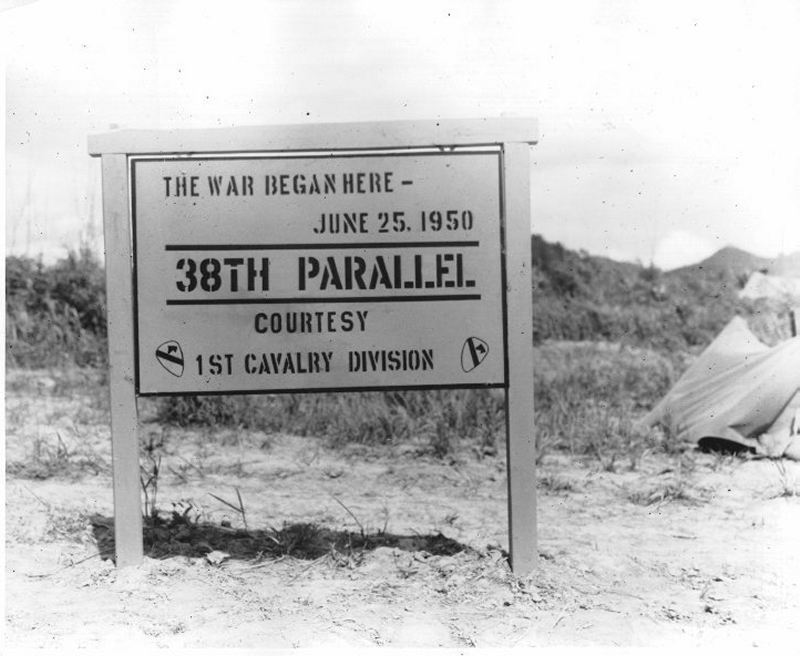
There was no “Liberation” of Korea following the entry of US forces. Quite the opposite. A US military government was established in South Korea on September 8, 1945, three weeks after the surrender of Japan on August 15th 1945. Moreover, Japanese officials in South Korea assisted the US Army Military Government (USAMG) (1945-48) led by General Hodge in ensuring this transition. Japanese colonial administrators in Seoul as well as their Korean police officials worked hand in glove with the new colonial masters.
While Japan was treated as a defeated Empire, South Korea was identified as a colonial territory to be administered under US military rule and US occupation forces. America’s handpicked appointee Sygman Rhee [left] was flown into Seoul in October 1945, in General Douglas MacArthur’s personal airplane
US Sponsored Military Dictatorship
The underlying model of military dictatorship applied in the ROK from 1945 to 1987 was not substantially different to what was imposed by Washington in Latin America and South East Asia.
As of the 1980s, a major shift in US foreign policy occurred. US interventionism was geared towards the replacement of military regimes by compliant “democratic governments”, which would not in any way weaken or jeopardize America’s interference in the internal affairs of sovereign states.
Most of the US sponsored military dictatorships in the course of the 1980s were replaced by US sponsored democracies, (e.g. Chile, Argentina, Brazil, Philippines, Indonesia). Meanwhile, US increasingly intervenes in national elections, promotes political leaders and instigates “regime change”.
What has developed in many countries is a facade of democracy, what might be described as a “democratic dictatorship”.
Sweeping macro-economic reforms are often imposed. Democratically elected leaders continue to be threatened if they do not conform, heads of state are often co-opted.
What the foregoing suggests is that the repeal of authoritarian rule in the ROK, with government’s run by the military replaced by an elected president, does not necessarily imply a shift in the structure of the State.
Financial Warfare directed against the Republic of Korea. The 1997-98 Asian Crisis
As we recall, in the ROK, the democratically elected president Kim Dae jung had been instructed by Washington in no uncertain terms (prior to the elections) to implement sweeping macro-economic reforms in response to the speculative onslaught against the Korean Won in 1997 at the height of the Asian crisis.
Succumbing to political pressure, president Kim Dae-jung, a former dissident, political prisoner and starch opponent of the US backed military regimes of Park Chung-hee and Chun Doo-hwan, had caved in to Wall Street and Washington prior to his formal inauguration as the country’s democratically elected president.
In fact Washington had demanded through its embassy in Seoul that all three candidates in the presidential race commit themselves to adopting the IMF sponsored “bailout”. Kim Dae-jung was committed to democracy and national sovereignty. He had the support of the Korean people. Yet what occurred was a process of political arm twisting both prior as well as in the wake of the 1997 presidential elections. Kim Dae jung remained firmly opposed to the IMF bailout agreement. He candidly warned public opinion and accused the outgoing government of organising a massive sell-out of the Korean economy:
“Foreign investors can freely buy our entire financial sector, including 26 banks, 27 securities firms, 12 insurance companies and 21 merchant banks, all of which are listed on the Korean Stock Exchange, for just 5.5 trillion won,’ that is, $3.7 billion.” (quoted in Michel Chossudovsky, The Globalization of Poverty and the New World Order, Global Research, Montreal, 2003)
The 1997 Asian crisis was engineered. It was the result of financial manipulation. The ROK had been the object of a deliberate process of economic destabilization instigated by powerful financial institutions. Yet in the wake of the election president Kim Dae-jung was obliged to conform to Washington’s demands.
What the foregoing signifies is that a democratically elected government does not in itself ensure democracy and national sovereignty.
Chapter VII
Reunification and the Road Ahead
There is Only One Korean Nation
America’s neo-colonial practice applied both prior and in the post World War period has been geared towards weakening the nation state. Washington seeks through military and non-military means the partition and fracture of independent countries. (eg. Yugoslavia, Czechoslovakia, Central America, Iraq, Syria, Sudan). This foreign policy agenda focussing on fracture and partition also applies to Korea.
There is only one Korean Nation. Washington opposes reunification because a united Korean Nation would weaken US hegemony in East Asia.
Reunification would create a competing industrial and military power and nation state (with advanced technological and scientific capabilities) which would assert its sovereignty, establish trade relations with neighbouring countries (including Russia and China) without the interference of Washington.
It is worth noting in this regard, that US foreign policy and military planners have already established their own scenario of “reunification” predicated on maintaining US occupation troops in Korea. Similarly, what is envisaged by Washington is a framework which would enable “foreign investors” to penetrate and pillage the North Korean economy.
Washington’s objective is to impose the terms of Korea’s reunification. The NeoCons “Project for a New American Century” (PNAC) published in 2000 had intimated that in a “post unification scenario”, the number of US troops (currently at 28,500) should be increased and that US military presence should be extended to North Korea.
In a reunified Korea, the stated military mandate of the US garrison would be to implement so-called “stability operations in North Korea”:
While Korea unification might call for the reduction in American presence on the peninsula and a transformation of U.S force posture in Korea, the changes would really reflect a change in their mission – and changing technological realities – not the termination of their mission. Moreover, in any realistic post-unification scenario, U.S. forces are likely to have some role in stability operations in North Korea. It is premature to speculate on the precise size and composition of a post-unification U.S. presence in Korea, but it is not too early to recognize that the presence of American forces in Korea serves a larger and longer-range strategic purpose. For the present, any reduction in capabilities of the current U.S. garrison on the peninsula would be unwise. If anything, there is a need to bolster them, especially with respect to their ability to defend against missile attacks and to limit the effects of North Korea’s massive artillery capability. In time, or with unification, the structure of these units will change and their manpower levels fluctuate, but U.S. presence in this corner of Asia should continue. 36
(PNAC, Rebuilding America`s Defenses, Strategy, Forces and Resources for a New Century, p. 18, emphasis added)
Washington’s intentions are crystal clear.
It should be understood that a US led war against North Korea would engulf the entire Korean nation.
The US sponsored state of war is directed against both North and South Korea. It is characterised by persistent military threats (including the use of nuclear weapons) against the DPRK.
It also threatens the ROK which has been under US military occupation since September 1945. Currently there are 28,500 US troops in South Korea. Yet under the US-ROK OPCON (joint defense agreement) discussed earlier, all ROK forces are under US command.
Given the geography of the Korean peninsula, the use of nuclear weapons against North Korea would inevitably also engulf South Korea. This fact is known and understood by US military planners.
What has to be emphasized in relation to Sunshine 2.0 Policy is that the US and the ROK cannot be “Allies” inasmuch as the US threatens to wage war on North Korea.
The “real alliance” is that which unifies and reunites North and South Korea through dialogue against foreign intrusion and aggression.
The US is in a state of war against the entire Korean Nation. And what this requires is:
the holding of bilateral talks between the ROK and the DPRK with a view to signing an agreement which nullifies the Armistice and sets the term of a bilateral “Peace Treaty”. In turn this agreement would set the stage for the exclusion of US military presence and the withdrawal of the 28,500 US forces.
Moreover, pursuant to bilateral Peace negotiations, the ROK-US OPCON agreement which places ROK forces under US command should be rescinded. All ROK troops would thereafter be brought under national ROK command.
Bilateral consultations should also be undertaken with a view to further developing economic, technological, cultural and educational cooperation between the ROK and the DPRK.
Without the US in the background pulling the strings under OPCON, the threat of war would be replaced by dialogue. The first priority, therefore would be to rescind OPCON.
Order Directly from Global Research Publishers
Towards a World War III Scenario: The Dangers of Nuclear War
Michel Chossudovsky

The US has embarked on a military adventure, “a long war”, which threatens the future of humanity. US-NATO weapons of mass destruction are portrayed as instruments of peace. Mini-nukes are said to be “harmless to the surrounding civilian population”. Pre-emptive nuclear war is portrayed as a “humanitarian undertaking”.
While one can conceptualize the loss of life and destruction resulting from present-day wars including Iraq and Afghanistan, it is impossible to fully comprehend the devastation which might result from a Third World War, using “new technologies” and advanced weapons, until it occurs and becomes a reality. The international community has endorsed nuclear war in the name of world peace. “Making the world safer” is the justification for launching a military operation which could potentially result in a nuclear holocaust.
The Globalization of War: America’s “Long War” against Humanity
Michel Chossudovsky

America’s hegemonic project in the post 9/11 era is the “Globalization of War” whereby the U.S.-NATO military machine —coupled with covert intelligence operations, economic sanctions and the thrust of “regime change”— is deployed in all major regions of the world. The threat of pre-emptive nuclear war is also used to black-mail countries into submission.
This “Long War against Humanity” is carried out at the height of the most serious economic crisis in modern history.
It is intimately related to a process of global financial restructuring, which has resulted in the collapse of national economies and the impoverishment of large sectors of the World population.
The ultimate objective is World conquest under the cloak of “human rights” and “Western democracy”.
The original source of this article is Global Research
--------------
Copyright © Prof Michel Chossudovsky, Global Research, 2017
Comment on Global Research Articles on our Facebook page
Become a Member of Global Research
Related Articles
False Alarm of Incoming (North Korean) Missile in Japan
Jan 18, 2018
North Korea is Not Seeking War. Committed to Peace
Jan 17, 2018
North Korea and Double Standards. Is the Vancouver Conference a Missed Opportunity?
Jan 17, 2018
North Korea and the Danger of Nuclear War: Michel Chossudovsky in Vancouver, January 16:
Jan 16, 2018
Trump’s Nuclear Posture Review: Planning for Nuclear War?
Jan 16, 2018
The Pentagon Papers and the Daniel Ellsberg Story You Won’t See in ‘The Post’
Jan 15, 2018
Articles by:Prof Michel Chossudovsky
About the author:Michel Chossudovsky is an award-winning author, Professor of Economics (emeritus) at the University of Ottawa, Founder and Director of the Centre for Research on Globalization (CRG), Montreal, Editor of Global Research. He has taught as visiting professor in Western Europe, Southeast Asia, the Pacific and Latin America. He has served as economic adviser to governments of developing countries and has acted as a consultant for several international organizations. He is the author of eleven books including The Globalization of Poverty and The New World Order (2003), America’s “War on Terrorism” (2005), The Global Economic Crisis, The Great Depression of the Twenty-first Century (2009) (Editor), Towards a World War III Scenario: The Dangers of Nuclear War (2011), The Globalization of War, America's Long War against Humanity (2015). He is a contributor to the Encyclopaedia Britannica. His writings have been published in more than twenty languages. In 2014, he was awarded the Gold Medal for Merit of the Republic of Serbia for his writings on NATO's war of aggression against Yugoslavia. He can be reached at crgeditor@yahoo.com
-------
Disclaimer: The contents of this article are of sole responsibility of the author(s). The Centre for Research on Globalization will not be
No comments:
Post a Comment
Note: Only a member of this blog may post a comment.